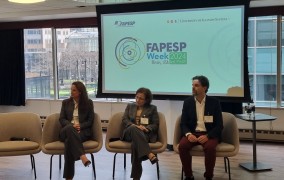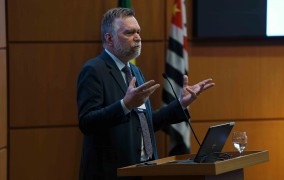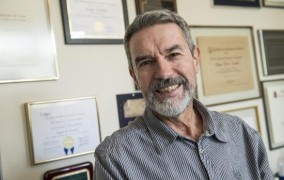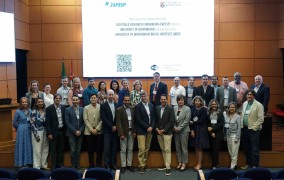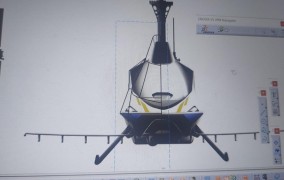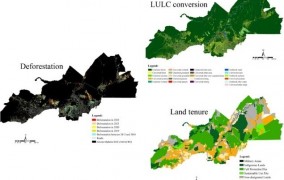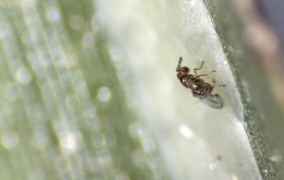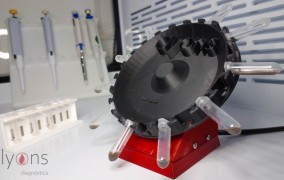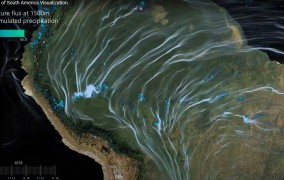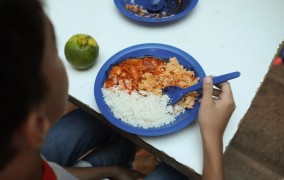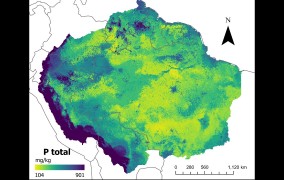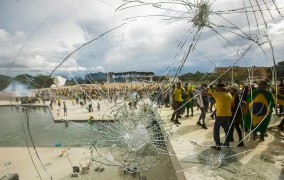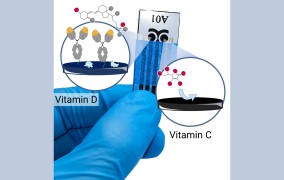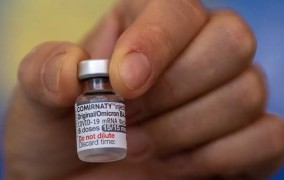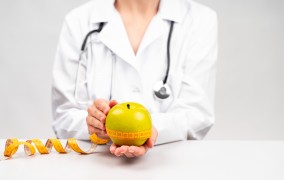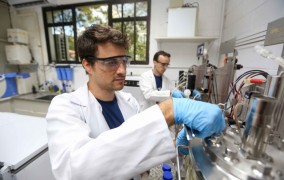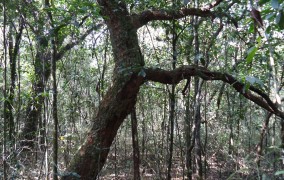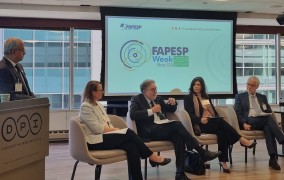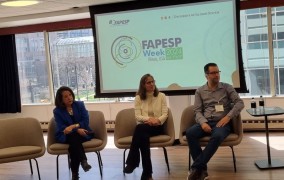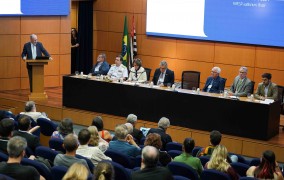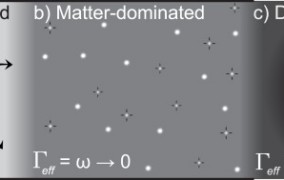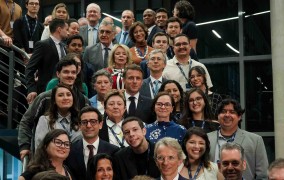
News
-
FAPESP, São Paulo State Government and German university THI sign cooperation agreement
2024-05-22The aim is to fund bilateral projects in the field of artificial intelligence, focusing on mobility, energy and security. -
Inflammation during pregnancy can cause cleft lip in individuals with a genetic predisposition
2024-05-22Through experiments with human cells and animals, researchers from the University of São Paulo and collaborators have shown how gene-environment interactions during the craniofacial development of the embryo can lead to malformations. -
Proteins modified in lungs offer clues to biological functions of bromine
2024-05-22Researchers at a FAPESP-supported research center showed that the addition of bromine to extracellular matrix proteins is a physiological modification dependent on the enzyme peroxidasin – the study extends knowledge of the scope of this enzyme’s activity in the mammalian organism. -
Aerobic exercise performed in the evening benefits elderly hypertensives more than morning exercise
2024-05-15A study conducted at the University of São Paulo with 23 volunteers found that only evening training regulated baroreflex sensitivity, a mechanism that compensates for abrupt changes in blood pressure. -
Bruxism is frequently observed in patients with post-traumatic stress disorder
2024-05-15This study was conducted at the University of São Paulo and published in Clinical Oral Investigations; the authors emphasize the importance of collaboration between dentists and psychiatrists to improve diagnosis and treatment. -
Plasma treatment of semiconductor films can improve hydrogen production
2024-05-15In an experiment resulting from collaboration between two FAPESP-supported research centers, a material was modified for use in solar-driven water splitting to produce hydrogen. -
A startup supported by FAPESP is conducting one of the largest studies on Huntington’s disease
2024-05-15BioDecision has developed a methodology that combines RNA sequencing and big data to offer the pharmaceutical industry molecular targets of interest for treatment of the disease. -
Researchers conduct first-ever study to characterize microbiota in saliva of weaned piglets on commercial farms in Brazil
2024-05-15Results show that oral fluid bacteria differ from fecal and environmental bacteria. Identification of these microorganisms can help diagnose infectious diseases and improve pork production. -
São Paulo School of Advanced Science presents innovative approach to environmental issues
2024-05-15Focus on transdisciplinarity aims to foster participation by all stakeholders in efforts to address global change. The subject was front and center at an event held in April 2024 at a historic town in São Paulo state. -
World experts create document on AI capabilities and risks
2024-05-15Director of the Institute of Mathematical and Computer Sciences at the University of São Paulo collaborates with work developed in the UK to guide governments. -
RCGI joins Shell’s energy transition center in the Netherlands
2024-05-15The new office is expected to serve as a research hub for the Research Center for Greenhouse Gas Innovation in Europe, fostering international partnerships. -
In a reservoir in Southeast Brazil, introduction of a fish native to the Amazon has reduced native species diversity
2024-05-13Since 2001, when it was first recorded in the Jaguarai reservoir in São Paulo state, the Silver croaker (Plagioscion squamosissimus) has established and increased its population in the Paraíba do Sul Basin to the detriment of native fish species. -
Cocaine is an emerging contaminant of concern in the Bay of Santos (Brazil), says researcher
2024-05-08The drug accumulates not only in water, but also in sediments and marine organisms, and poses a high ecological risk, said Camilo Seabra, a professor at the Federal University of São Paulo, during FAPESP Week Illinois. -
Laser printing on fallen tree leaves produces sensors for medical and laboratory use
2024-05-08Leaf cellulose is converted by pyrolysis to graphite, which is printed in the right shape for the surface to function as a sensor. Tests to determine concentrations of dopamine and paracetamol confirmed that the sensor performed successfully. -
Almost 30% of children and adolescents experience pain in muscles, bones or ligaments, study shows
2024-05-08A survey conducted in Brazil provides an overview of musculoskeletal pain in the very young. Back pain and leg pain were the most frequent complaints among 2,688 volunteers aged 12 on average. -
Third 2024 FAPESP Lecture discusses training of physician-scientists in the United States
2024-05-08The lecture was delivered by Antonio Bianco, a professor of medicine at the University of Chicago who has won several awards for research in the thyroid field. -
Brazilian researcher receives one of the most important awards in the field of glass materials
2024-05-08Edgar Dutra Zanotto, coordinator of the Center for Teaching, Research and Innovation in Glass, was invited by the American Ceramic Society to give the Varshneya Frontiers of Glass Science Lecture. -
Study focusing on primary care seeks to improve diagnosis and management of chronic obstructive pulmonary disease
2024-05-08The project, conducted by researchers affiliated with the University of São Paulo in Brazil and the University of Birmingham in the UK, was one of 15 presented at an event held to celebrate the partnership between the British institution and FAPESP. It also marked the launch of the University of Birmingham Brazil Institute, whose mission is to bolster UK-Brazil research collaboration. -
Brazilian startup designs self-flying aerial vehicle for crop spraying
2024-05-08The firm is supported by FAPESP and is developing an autonomous helicopter capable of spraying crops on steep hillsides. -
Educational game raises awareness among young people about measures to combat dengue fever
2024-05-08Game challenges the player to find and eliminate all Aedes aegypti mosquito hotspots. -
In Brazil, 76% of deforestation in three Amazonian states occurred in a planned agricultural development zone
2024-05-06The researchers showed that pressure has intensified since the 2018 announcement of a plan to create a development zone where the states of Amazonas, Acre and Rondônia meet. -
Loss of large herbivores affects interactions between plants and their natural enemies, study shows
2024-05-06Researchers in Brazil compared leaf damage caused by insects and pathogens in areas with and without the presence of mammals such as tapirs, deer and peccaries. Absence of the animals led to loss of microorganisms that cause leaf disease, potentially affecting long-term eco-evolutionary processes and reducing biodiversity in tropical forests. -
Wildfires in old-growth Amazon forest areas rose 152% in 2023, study shows
2024-05-01The increase was confirmed by an analysis of satellite images, contrasting with a drop in deforestation and the total number of fires detected in the Amazon. The Brazilian government’s center for forest fire prevention says it is partnering with other institutions to combat wildfires in the region. -
Registration of biological pest control products exceeds that of agrochemicals in Brazil
2024-05-01Around 90% of the sugarcane area in Brazil now uses natural enemies to combat agricultural pests; data were presented during FAPESP Week Illinois. -
Test will permit relatively non-invasive detection of micrometastasis
2024-05-01A Brazilian startup supported by FAPESP is developing a solution to detect a biomolecule linked to the presence of migratory oral cancer cells. -
Study helps understand how energy metabolism is regulated at cellular level
2024-05-01An article published by a FAPESP-supported research center highlights the link between mitochondrial calcium transport and autophagy, the process whereby cells break down and reuse some of their own components. -
International group runs simulations capable of describing South America’s climate with unprecedented accuracy
2024-05-01The aim is to create a computer visualization model that more accurately represents the hydroclimatic processes that occur in the region and to support climate change adaptation measures; the initiative was presented during FAPESP Week Illinois. -
Analysis of flour and rice shows high levels of harmful fungal toxins
2024-05-01The foods, found in the homes of Brazilian families participating in the research, were stored for future consumption. The study is the first in Brazil to use biomarkers to characterize the risk associated with mycotoxins in the diet. -
Research shows link between pollution and heart risks in residents of the city of São Paulo, Brazil
2024-04-29A study by the University of São Paulo, published in the journal Environmental Research, analyzed the results of the autopsies of 238 people and epidemiological data; the risk is greater for hypertensive patients. -
Maps developed with artificial intelligence confirm low levels of phosphorus in Amazonian soil
2024-04-29Research introduces new methodology to describe the amount of the mineral, which is important in the growth cycle of vegetation and can affect the forest’s response to climate change. -
Theories that explain the crisis in democracy are inadequate for Latin America, experts say
2024-04-24Countries in the region are experiencing a different phenomenon from that observed in the United States and Europe, where increased social inequality may have been the cause of the advance of political polarization. The assessment was made by participants in FAPESP Week Illinois. -
Bioelectronic chip detects vitamins C and D in saliva in under 20 minutes
2024-04-24The device was developed at the University of São Paulo and can be used for self-monitoring of micronutrients, assistance with personalized diets, and prevention of deficiencies and toxicity. -
Study confirms effectiveness of bivalent COVID-19 vaccine
2024-04-24Brazilian scientists conducted the first research project to evaluate the immunity induced in an actual group of vaccinated subjects. Their findings are reported in the Journal of Medical Virology. -
Researchers test new behavioral health interventions
2024-04-24Group from the University of Illinois in Chicago creates program to stimulate math learning through physical activity; results of the work were presented at FAPESP Week Illinois. -
Food insecurity is significant among inhabitants of the region affected by the Belo Monte dam in Brazil
2024-04-24A study of 500 households in Altamira, a city near the dam in Pará state, showed that 61% experienced food insecurity. -
Technology for local production of industrial enzymes in Brazil
2024-04-24A startup supported by FAPESP is developing a platform that will enable local production of enzymes to act as catalysts for chemical reactions. -
Light-activated materials perform well in treatment of textile effluent
2024-04-24Investigators affiliated with two FAPESP-supported research centers conducted an experiment using actual effluent from the textile industry. The results are detailed in the journal Chemosphere. -
Without proper management, Cerrado becomes disfigured and less resilient to climate change
2024-04-22A study conducted over a period of 14 years in the Brazilian savanna-like biome shows its typical vegetation rapidly becoming ‘cerradão’ – a biodiversity-poor forest formation – while resistance to drought and wildfires weakens. -
FAPESP seeks to increase research collaboration with the US Midwest
2024-04-17Researchers from universities and research institutions in the State of São Paulo participate in FAPESP Week Illinois; the event aims to create new opportunities for scientific cooperation. -
Air pollution data could be used to plan better transit routes
2024-04-17Researchers from the University of São Paulo are producing maps that show areas of the city of São Paulo with the highest concentration of air pollutants; the results of the studies were presented in the United States during FAPESP Week Illinois. -
DNA vaccine against zika performs well in tests on mice
2024-04-17The vaccine is being developed by researchers in Brazil. The results of preclinical trials are published in the journal Frontiers in Immunology. -
Consortium including Brazilians sequences the reference genome of Arabica coffee
2024-04-17The work makes it possible to tell the story of the fusion of genomes that gave rise to the world’s most consumed species, as well as identifying genes responsible for resistance to rust and other diseases. -
Arboviruses, mosquitoes and potential hosts tracked in real time in São Paulo city
2024-04-17The technology used to sequence the first infections by SARS-CoV-2 at record speed has been successfully tested as a technique to monitor viruses transmitted by mosquitoes, such as dengue, zika, chikungunya and yellow fever. -
PROASA program will advance knowledge of South Atlantic and Antarctic
2024-04-17Launched on April 2 at FAPESP, the program will initially involve researchers from Brazil, Argentina and France. -
Startup develops alternative treatment for atopic dermatitis
2024-04-17Researchers supported by FAPESP have created a drug using antibodies for direct application to the skin. -
UNESP professor brings together accounts of journeys to inhospitable places and reflections on the future in book
2024-04-17Written by São Paulo State University’s biologist Mauro Galetti Rodrigues, A Naturalist in the Anthropocene aims to inspire young scientists and nature lovers. -
Ludo Educativo games portal surpasses 20 million views
2024-04-17Dissemination project of the Center for the Development of Functional Materials – a research center supported by FAPESP and based at the Federal University of São Carlos – is aimed at primary and secondary school students and teachers. -
Study uses thermodynamics to describe expansion of the Universe
2024-04-15The shift from a decelerating expansion regime (in the radiation- and matter-dominated era) to an accelerating expansion regime (in the dark energy-dominated era) resembles a thermodynamic phase transition, according to an article in Results in Physics by scientists affiliated with São Paulo State University. -
Hydrogen recombination found to be most plausible explanation for high levels of energy in stellar superflares
2024-04-15The study investigated 42 superflares and concluded that this model is more consistent from the physical standpoint. -
French President Emannuel Macron unveils a branch of Institut Pasteur at the University of São Paulo
2024-04-10The new member of the Pasteur Network, which comprises 33 laboratories in 25 countries, is being equipped with the support of FAPESP, which is also funding several young researchers associated with the institute.
Most popular
-
Study identifies molecular alterations in brain tissue and blood of people who committed suicide
2024-03-13
-
Study helps explain why stress in adolescence can lead to predisposition to mental illness in adulthood
2024-01-24
-
Study shows that Rio Grande Rise was once a giant mineral-rich tropical island near Brazil
2024-01-31
-
Butantan Institute’s dengue vaccine protects 79.6% of those vaccinated, study shows
2024-02-01
-
Brazilian researcher helps describe a novel species of jellyfish discovered in a remote location in Japan
2024-01-31
-
Growth hormone influences regulation of anxiety via a specific group of neurons
2024-01-02
-
Amphibians use scream inaudible to humans for self-defense against predators, study suggests
2024-04-03
-
Biodegradable sensor monitors levels of pesticides via direct contact with surface of fruit and vegetables
2024-01-31
-
Weight training improves symptoms of anxiety and depression in old people, study confirms
2024-04-10
-
Study reveals evidence of violence at a time of crisis in ancient Peru
2024-03-27

















